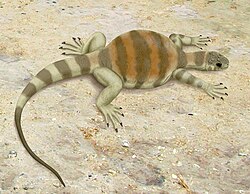 |
| Spawning team for turtles on the beach |
Six months ago its mother buried a clutch of eggs. All around this pioneer the sand shifts as more baby turtles claw their way out of their shells towards the surface. As soon as they are free, they scurry as quickly as they can towards the sea, tumbling down the sand dunes into the froth of the waves. In 30 years they will return and lay eggs of their own, to start the cycle again.
The ritual of turtles hatching from sand-swamped eggs is most likely as old as the group themselves, extending back in time to the first chelonians (turtles) on Earth. The fact that the same kind of behavior (burying eggs close to a body of water) is found in all members of the group means we can be pretty certain about this. What is less certain is what the first chelonian on Earth was like or when it lived. A discovery made in 2008 of a creature known as Odontochelys semitestacea set the benchmark at 220 million years ago.
 |
| A fossil of the 260 million year old Eunotosaurus africanus, the oldest known turtle on Earth |
This creature's morphology, however, was by no means primitive. It had a fully developed plastron (the shell on the underside of the body) and broadened ribs which were well on the way to becoming the supports for a scaly carapace on its back. There was no way that this odd creature was the first turtle on the planet. Indeed, the first turtles with fully formed shells appear in the fossil record just 10 million years later.
For years Odontochelys remained paleontology's best attempt to get close to the earliest chelonians. Yet now, a discovery from South Africa has pushed the group's evolutionary history back by an incredible 40 million years, a massive jump in terms of the history of animal life.
The first specimens of Eunotosaurus africanus were actually found in 1892 in South Africa in 260 million year old rocks. It was only in 1914 that British Zoologist D.M.S Watson classified it as a chelonian.
The first specimens of Eunotosaurus africanus were actually found in 1892 in South Africa in 260 million year old rocks. It was only in 1914 that British Zoologist D.M.S Watson classified it as a chelonian.
For years specimens of Eunotosaurus remained simply as proof of the existence of yet another denizen of the fossil record until its bones were re-examined in detail earlier this year by Dr Tyler Lyson from the Smithsonian National Museum of Natural History. The study revealed the presence of multiple primitive versions of features found in more advanced turtles both in the fossil record and alive today. The most prominent examples are no intercostal muscles running in between the ribs, paired belly ribs and a specialized mode of rib development, all of which indicate that Eunotosaurus represents one of the first species to form the evolutionary branch of turtles.
'Eunotosaurus neatly fills an approximately 30-55-million year gap in the turtle fossil record,' said Dr Tyler Lyson. 'There are several anatomical and developmental features that indicate Eunotosaurus is an early representative of the turtle lineage; however, its morphology is intermediate between the specialized shell found in modern turtles and primitive features found in other vertebrates. As such, Eunotosaurus helps bridge the morphological gap between turtles and other reptiles.'
 |
| An artist's impression of Eunotosaurus africanus |
What is interesting is what this tells us about why turtles took on their distinctive form. The fossil of Eunotosaurus shows that it was a land-based creature, confirming the theory that chelonians were terrestrial in origin. As a result, we can say that turtles would have made a gradual move into water. The early forms, which may have included Eunotosaurus, would have lived in the shallows. The flatter, wider bodies supported by the wide ribs would have made movement in shallow water easier as well as giving them some hydrodynamic properties.
In later forms, such as Odontochelys, the plastron was the first part of the shell to develop. The trigger for developing any type of armour is biological defence. The Permian seas were filled with predatory fish. During the Great Dying, an extinction event which wiped out 90% of marine life, oceanic predators all but vanished as food webs collapsed. This gave turtles the chance to make their move into the oceans. When predators returned, the newly marine chelonians required a form of defence. As surface dwellers, they were most vulnerable to attacks from below and so evolved the plastron.
Marine reptiles were quite common by 220 million years ago, providing the selective pressure which resulted in the perfection of the turtle's shell 10 million years later. Indeed it is wonderful to think that the drama played out on the beaches of Australia is a microcosm of the evolutionary struggle which resulted in the first turtles to walk on the face of the Earth and of their descendants who later swam through its oceans.